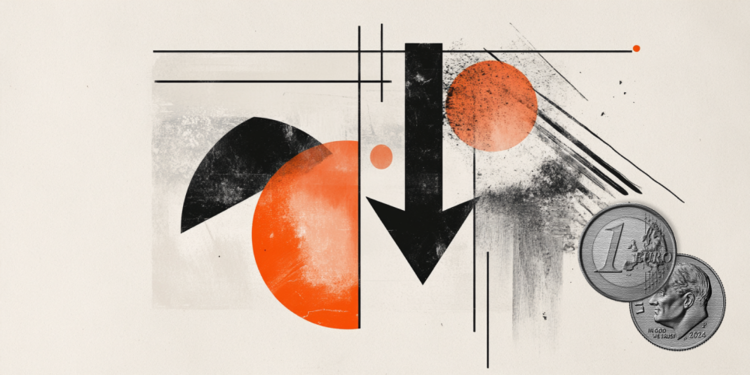- Indian rupee wins traction in the Asian session on Thursday.
- The strength of Asian currencies and a weaker US dollar support the INR.
- The preliminary reports of the HSBC PMI of India and the US PMI of the US S&P for May will be the points highlighted later on Thursday.
Indian rupee (INR) gains strength on Thursday. The strength of Asian currencies, an American dollar (USD) weaker and lower prices of crude oil provide some support to the Indian currency. In addition, a commercial agreement in multiple phases between the US and India could contribute to the increase in INR. However, the growing expectation that the Indian Reserve Bank (RBI) will make a rate cut at its next meeting of the Monetary Policy Committee could undermine the local currency.
Investors will be attentive to the preliminary reading of the Indian HSBC PMI) Purchase Management Index, which will be published later on Thursday. On the US Agenda, the S&P advanced PMI will be published for May, the National Activity Index of the Chicago Fed, the initial applications of unemployment subsidy and the sales reports of existing housing.
Indian rupee is strengthened while a weaker US dollar limits the fall
- India’s Minister of Commerce and Industry, Piyush Goyal, said India and the US could end the first phase of the Indian Commercial Agreement. before July.
- The monthly RBI bulletin published in May indicated that the overall growth prospects remain fragile despite the fact that the US has paused tariffs. The RBI added that high political uncertainty and the weak feeling of the consumer weighed on perspectives.
- Moody’s Ratings said Wednesday that India is well positioned to face the negative effects of US tariffs and global commercial interruptions, since the drivers of internal growth and low dependence on exports anchor the economy.
- The president of the House of Representatives, Mike Johnson, said that Trump met with the House Republicans on Tuesday and failed to convince the dissidents of his party to support his broad fiscal bill. The hard Republicans continue to argue that the bill does not sufficiently cut expense.
- Several officials of the Federal Reserve (FED) indicated in speeches this week that it is unlikely that the Central Bank of the United States will reduce its key federal fund rate in their two meetings of this summer.
- The markets have discounted almost 71% probability that the FED maintain its stable interest rates in their next two meetings, according to the CME Fedwatch tool.
The Basist Perspective of the USD/INR is still in force below the 100 -day EMA
Indian rupee is strengthened in the day. The USD/INR pair maintains a bassist tone in the daily temporal framework, with the price remaining limited below the average exponential mobile (EMA) key of 100 days. The 14 -day relative force (RSI) index remains around the midline. This indicates a short -term neutral momentum, suggesting that greater consolidation or temporary recovery cannot be ruled out.
The minimum of May 19 at 85.34 acts as an initial support level for the USD/INR. Any additional sale below this level could see a fall towards the psychological level of 85.00, followed by 84.61, the minimum of May 12.
On the other hand, the crucial resistance level to observe is the 100 -day Ema at 85.60. A decisive rupture above the level mentioned could potentially raise the torque again to 85.85, the upper limit of the trend channel.
India Faqs Rupia
Indian rupee (INR) is one of the most sensitive currencies to external factors. The price of crude oil (the country depends largely on imported oil), the value of the US dollar (most of the trade is carried out in US dollars) and the level of foreign investment are all influential factors. The direct intervention of the Bank of the Reserve of India (RBI) in the currency markets to keep the exchange rate stable, as well as the level of the interest rates set by the RBI, are other important factors that influence the rupee.
The Bank of the Reserve of India (RBI) actively intervenes in the currency markets to maintain a stable exchange rate and help facilitate trade. In addition, the RBI tries to maintain the inflation rate in its 4% target adjusting interest rates. Higher interest rates often strengthen rupee. This is due to the role of the “Carry Trade”, in which investors borrow in countries with lower interest rates to place their money in countries that offer relatively higher interest rates and benefit from difference.
Macroeconomic factors that influence the value of rupee include inflation, interest rates, economic growth rate (GDP), trade balance and foreign investment tickets. A higher growth rate can lead to greater investment abroad, increasing the demand for rupee. A less negative trade balance will eventually lead to a stronger rupee. The highest interest rates, especially real types (less inflation interest rates) are also positive for rupee. A risk environment can generate higher direct and indirect foreign investment entries (FI and FII), which also benefit the rupee.
Higher inflation, particularly if it is comparatively higher than other countries, is generally negative for the currency, since it reflects a devaluation through excess supply. Inflation also increases the cost of exports, which leads to more rupees to buy foreign imports, which is negative for Indian rupee. At the same time, higher inflation usually leads to the Bank of the Reserve of India (RBI) to raise interest rates and this can be positive for rupee, due to the increase in demand for international investors. The opposite effect applies to lower inflation.
Source: Fx Street
I am Joshua Winder, a senior-level journalist and editor at World Stock Market. I specialize in covering news related to the stock market and economic trends. With more than 8 years of experience in this field, I have become an expert in financial reporting.







